Highly Sensitive Microwave Sensors Based on Open Complementary Square Split-Ring Resonator for Sensing Liquid Materials
Abstract
:1. Introduction
2. Materials and Methods
- Initially, a microwave sensor is designed by selecting the operating frequency and dielectric material.
- The designed sensor is tested with different liquid materials such as ethanol, methanol, and distilled water.
- In the next step, the sensitivity is calculated, and the sensor is tested to achieve the highest frequency shift.
- If the proposed sensor fails to exhibit satisfactory sensitivity of at least 200 MHz/RIU, then the number of rings in the OCSSRR is increased to achieve the highest sensitivity.
- The fabricated sensors are measured and validated using a Vector Network Analyzer (VNA) to determine the sensitivity.
- Finally, the simulated and measured results are validated, and the sensor is ready for practical applications.
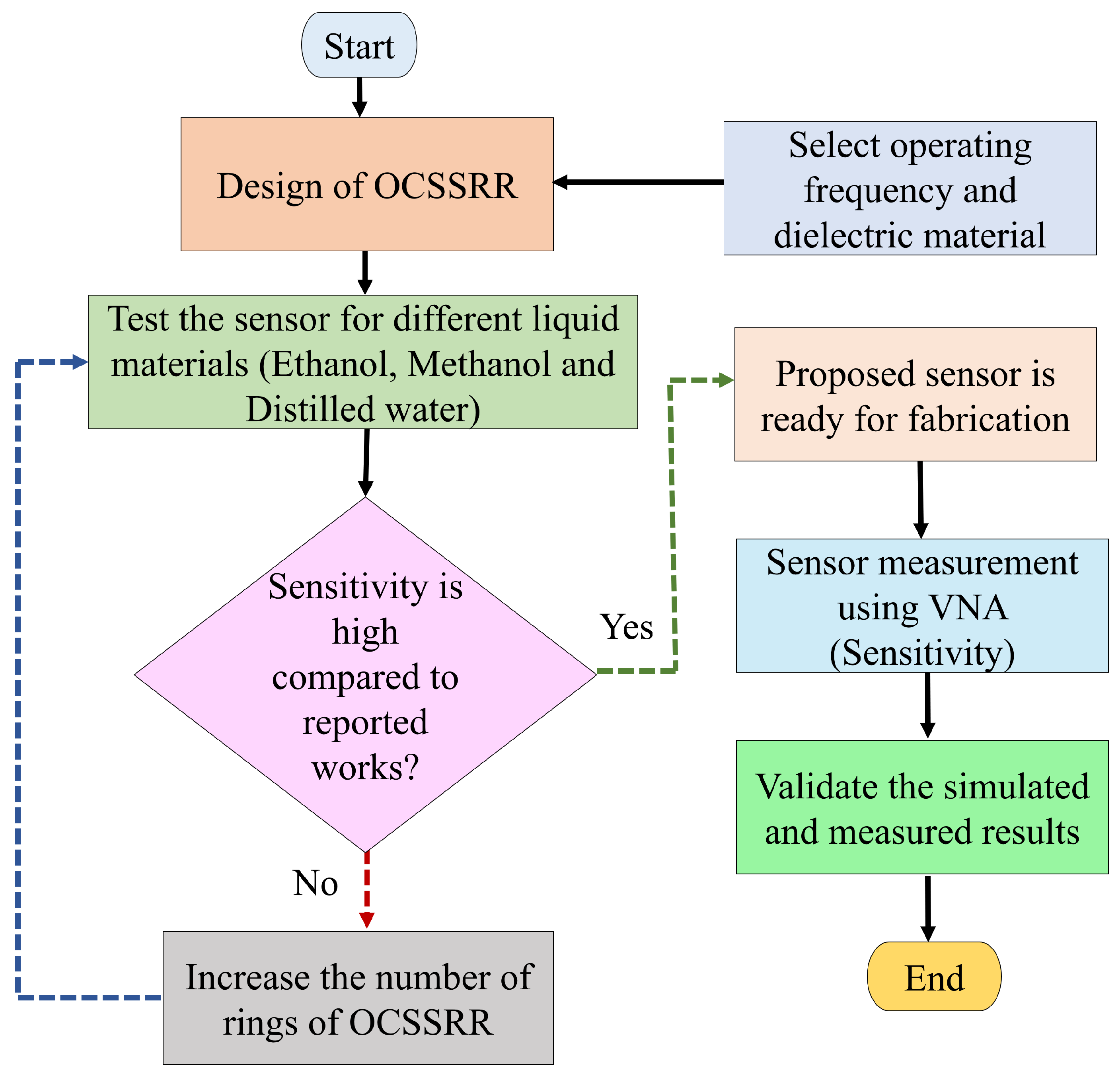
3. Sensors Design and Analysis
3.1. Open Complementary Square Split-Ring Resonator (OCSSRR)—Sensor 1
- Initially, a single square patch is chosen (called structure 1) that resonates at a frequency of 6.5 GHz as shown in Figure 2. As there is no sensing element, structure 1 cannot function as a sensor.
- A complimentary ring is added in structure 2, and the sensing region is positioned at the top plane. This is referred to as sensor 1.
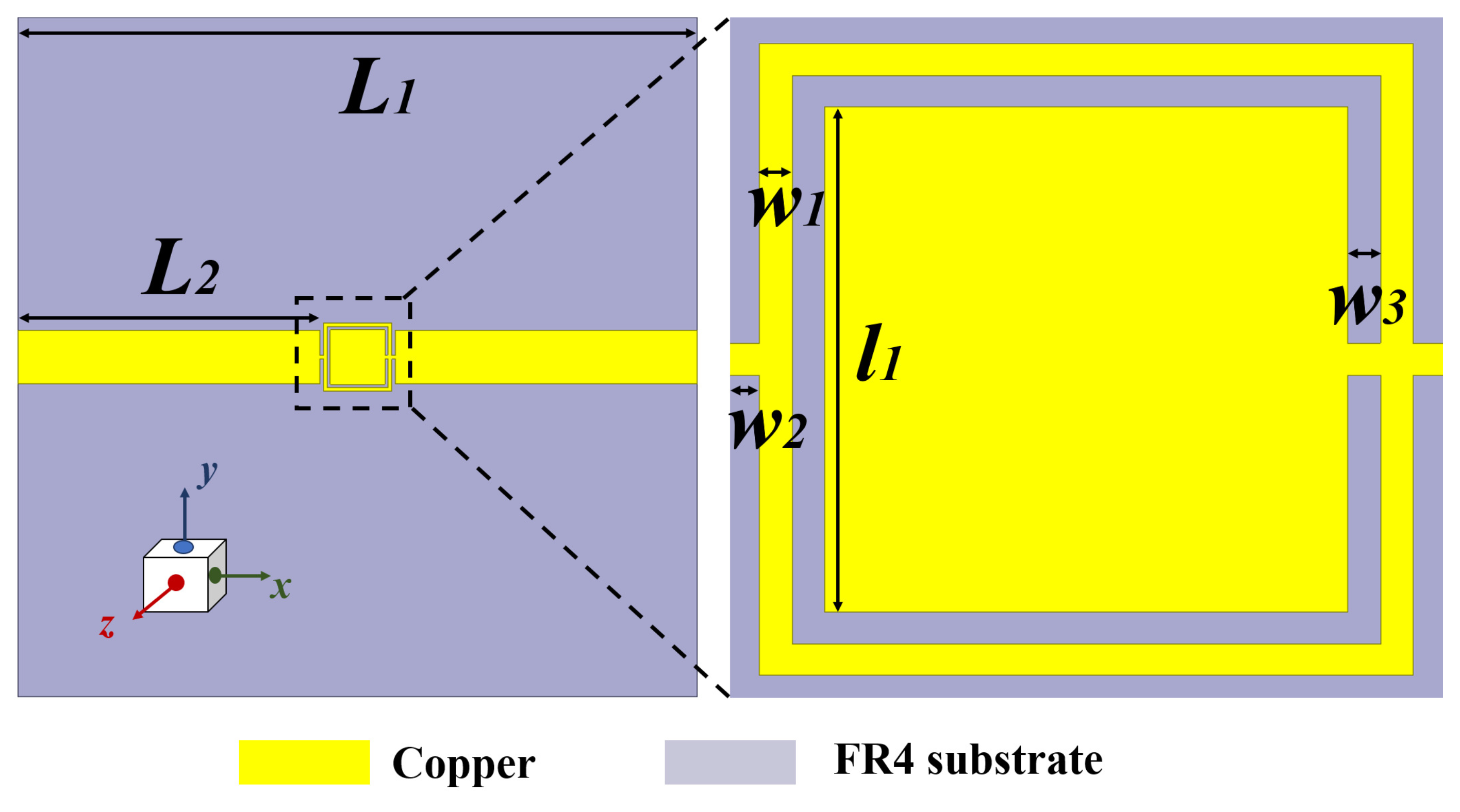
Parametric Analysis of OCSSRR—Sensor 1
3.2. Modified Open Complementary Square Split-Ring Resonator (OCSSRR)—Sensor 2
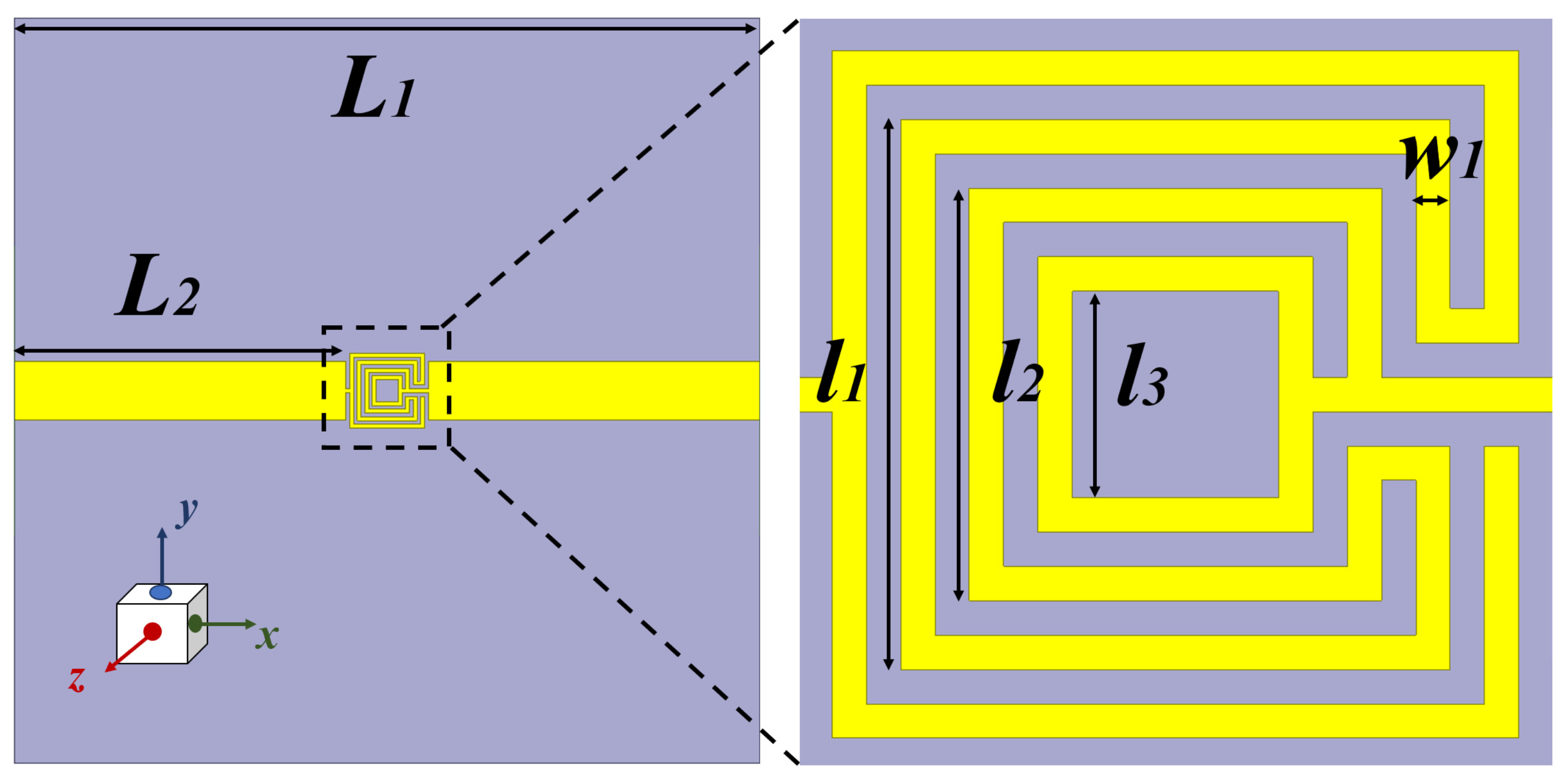
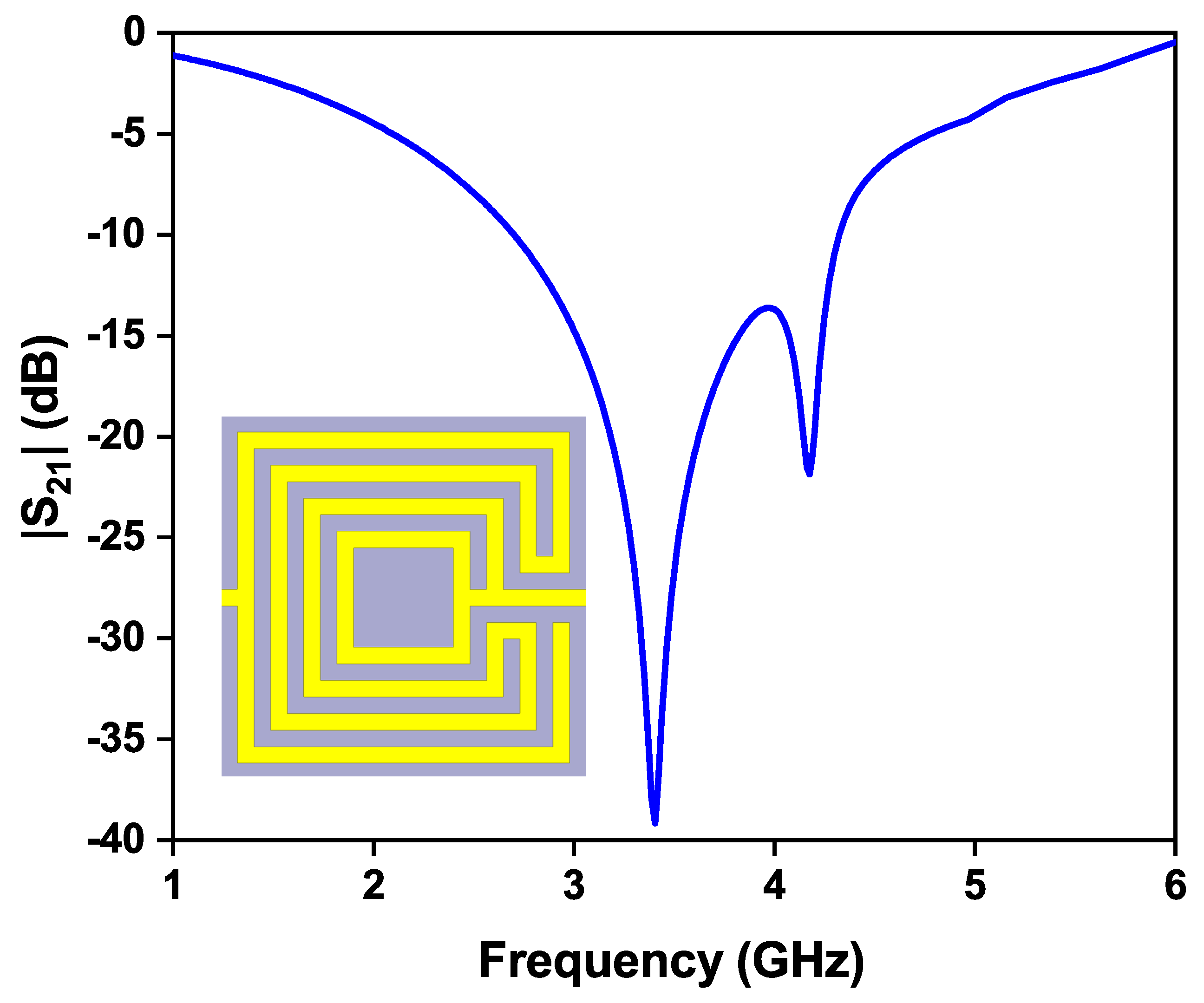

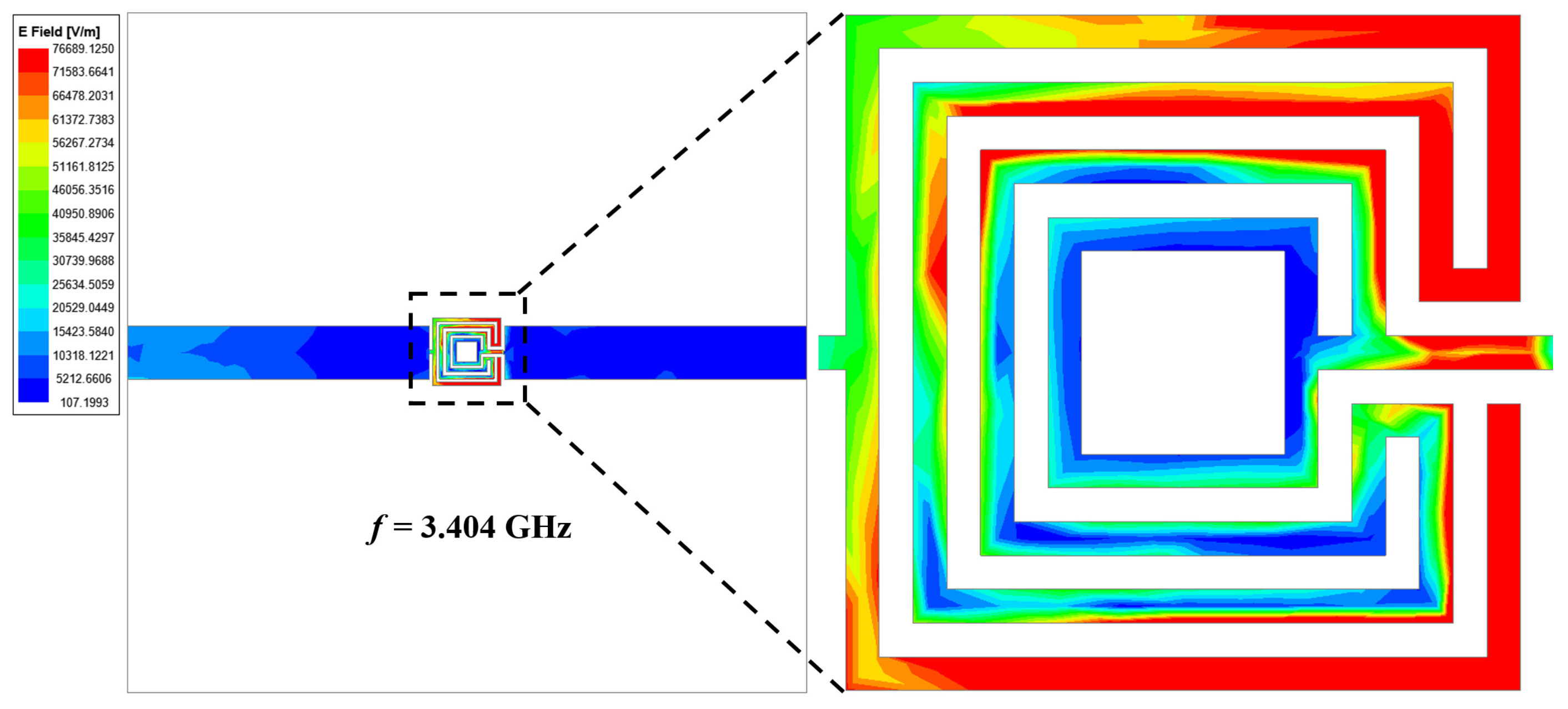
3.3. Performance Analysis of Sensor 1 and Sensor 2
3.3.1. Response of OCSSRR for Different Concentrations of Distilled Water
3.3.2. Modified OCSSRR for Sensing Different Concentrations of Distilled Water
4. Results and Discussion
4.1. Liquid Materials under Test
4.2. Sensitivity Analysis
5. Conclusions
Author Contributions
Funding
Institutional Review Board Statement
Informed Consent Statement
Data Availability Statement
Acknowledgments
Conflicts of Interest
References
- Ray, A.S. Remote sensing in agriculture. Int. J. Environ. Agric. Biotechnol. 2016, 1, 238540. [Google Scholar] [CrossRef]
- Reimer, T.; Pistorius, S. Review and Analysis of Tumour Detection and Image Quality Analysis in Experimental Breast Microwave Sensing. Sensors 2023, 23, 5123. [Google Scholar] [CrossRef] [PubMed]
- Xu, F.; Su, S.; Zhang, L.; Ren, T. Design and Research of Wireless Passive High-Temperature Sensor Based on SIW Resonance. Micromachines 2022, 13, 1035. [Google Scholar] [CrossRef] [PubMed]
- Nyfors, E. Industrial microwave sensors—A review. Subsurf. Sens. Technol. Appl. 2000, 1, 23–43. [Google Scholar] [CrossRef]
- Kakani, P.N.; Chandu, D.; Karthikeyan, S. Open complementary split ring resonator based RF sensor with improved sensitivity for detection and estimation of adulteration in edible oils. In Proceedings of the 2019 TEQIP III Sponsored International Conference on Microwave Integrated Circuits, Photonics and Wireless Networks (IMICPW), Tiruchirappalli, India, 22–24 May 2019; pp. 479–482. [Google Scholar]
- Li, Z.; Meng, Z.; Gibson, A. Detection of nonmetallic contaminants in lubricating oil using a microwave rectangular cavity resonator sensor. IEEE Trans. Instrum. Meas. 2023, 72, 1–10. [Google Scholar] [CrossRef]
- Zhao, D.; Zhu, B.; Li, L.; Liu, X.; Wen, L.; Song, Y.; Shen, H.; Li, M.; Li, X.; Wu, D. A Review of Methods for Measuring Oil Moisture. Measurement 2023, 217, 113119. [Google Scholar] [CrossRef]
- Shahzad, W.; Hu, W.; Ali, Q.; Raza, H.; Abbas, S.M.; Ligthart, L.P. A Low-cost metamaterial sensor based on DS-CSRR for material characterization applications. Sensors 2022, 22, 2000. [Google Scholar] [CrossRef]
- Chai, R.; Kong, X.; Wang, X. Development of non-contact detection device for coal moisture based on microwave transmission method. In Proceedings of the 2023 IEEE 3rd International Conference on Power, Electronics and Computer Applications (ICPECA), Shenyang, China, 29–31 January 2023; pp. 723–727. [Google Scholar]
- Mohammadi, P.; Mohammadi, A.; Kara, A. Dual Frequency Microwave Resonator for Non-invasive detection of Aqueous Glucose. IEEE Sens. J. 2023, 23, 21246–21253. [Google Scholar] [CrossRef]
- Singh, T.; Mishra, P.K.; Pal, A.; Tripathi, V.S. A planar microwave sensor for noninvasive detection of glucose concentration using regression analysis. Int. J. Microwave Wireless Technol. 2023, 15, 1343–1353. [Google Scholar] [CrossRef]
- Kiani, S.; Rezaei, P. Microwave Substrate Integrated Waveguide Resonator Sensor for Non-Invasive Monitoring of Blood Glucose Concentration: Low Cost and Painless Tool for Diabetics. Measurement 2023, 219, 113232. [Google Scholar] [CrossRef]
- Kiani, S.; Rezaei, P.; Navaei, M.; Abrishamian, M.S. Microwave sensor for detection of solid material permittivity in single/multilayer samples with high quality factor. IEEE Sens. J. 2018, 18, 9971–9977. [Google Scholar] [CrossRef]
- Ansari, M.A.H.; Jha, A.K.; Akhter, Z.; Akhtar, M.J. Multi-band RF planar sensor using complementary split ring resonator for testing of dielectric materials. IEEE Sens. J. 2018, 18, 6596–6606. [Google Scholar] [CrossRef]
- Saadat-Safa, M.; Nayyeri, V.; Khanjarian, M.; Soleimani, M.; Ramahi, O.M. A CSRR-based sensor for full characterization of magneto-dielectric materials. IEEE Trans. Microw. Theory Tech. 2019, 67, 806–814. [Google Scholar] [CrossRef]
- Ali, L.; Wei, J.; Meng, F.Y.; Qureshi, M.W.; Adhikari, K.K.; Li, M.Y.; Liang, J.G.; Wang, X.L.; Ding, X.M.; Kim, N.Y.; et al. Sensitivity–Enhanced Detection of Acetone Gas Using MXene-Immobilized Planar Microwave Sensor. Sens. Actuators B Chem. 2023, 392, 134048. [Google Scholar] [CrossRef]
- Pavel, I.A.; Lasserre, A.; Simon, L.; Rossignol, J.; Lakard, S.; Stuerga, D.; Lakard, B. Microwave Gas Sensors Based on Electrodeposited Polypyrrole–Nickel Phthalocyanine Hybrid Films. Sensors 2023, 23, 5550. [Google Scholar] [CrossRef] [PubMed]
- Wang, N.; Tao, W.; Zhang, N.; Wang, T.; Wang, X.; Liu, F.; Yan, X.; Liu, F.; Liang, X.; Sun, P.; et al. Unlocking the potential of organic-inorganic hybrids in microwave gas sensors: Rapid and selective NH3 sensing at room-temperature. Sens. Actuators B Chem. 2023, 378, 133112. [Google Scholar] [CrossRef]
- Ryecroft, S.P.; Shaw, A.; Fergus, P.; Kot, P.; Hashim, K.; Conway, L.; Moody, A. A novel gesomin detection method based on microwave spectroscopy. In Proceedings of the 2019 12th International Conference on Developments in eSystems Engineering (DeSE), Kazan, Russia, 7–10 October 2019; pp. 429–433. [Google Scholar]
- Al-Gburi, A.J.A.; Zakaria, Z.; Rahman, N.A.; Althuwayb, A.; Ibrahim, I.M.; Saeidi, T.; Dayo, Z.A.; Ahmad, S. A Miniaturized and Highly Sensitive Microwave Sensor Based on CSRR for Characterization of Liquid Materials. Materials 2023, 16, 3416. [Google Scholar] [CrossRef]
- Wang, C.; Liu, X.; Huang, Z.; Yu, S.; Yang, X.; Shang, X. A sensor for characterisation of liquid materials with high permittivity and high dielectric loss. Sensors 2022, 22, 1764. [Google Scholar] [CrossRef]
- Ebrahimi, A.; Scott, J.; Ghorbani, K. Ultrahigh-sensitivity microwave sensor for microfluidic complex permittivity measurement. IEEE Trans. Microw. Theory Tech. 2019, 67, 4269–4277. [Google Scholar] [CrossRef]
- Salim, A.; Lim, S. Complementary split-ring resonator-loaded microfluidic ethanol chemical sensor. Sensors 2016, 16, 1802. [Google Scholar] [CrossRef]
- Fan, L.C.; Zhao, W.S.; Wang, D.W.; Liu, Q.; Chen, S.; Wang, G. An ultrahigh sensitivity microwave sensor for microfluidic applications. IEEE Microw. Wirel. Compon. Lett. 2020, 30, 1201–1204. [Google Scholar] [CrossRef]
- Mohd Bahar, A.A.; Zakaria, Z.; Md. Arshad, M.; Isa, A.; Dasril, Y.; Alahnomi, R.A. Real time microwave biochemical sensor based on circular SIW approach for aqueous dielectric detection. Sci. Rep. 2019, 9, 5467. [Google Scholar] [CrossRef]
- Abdolrazzaghi, M.; Daneshmand, M.; Iyer, A.K. Strongly enhanced sensitivity in planar microwave sensors based on metamaterial coupling. IEEE Trans. Microw. Theory Tech. 2018, 66, 1843–1855. [Google Scholar] [CrossRef]
- Alhegazi, A.; Zakaria, Z.; Shairi, N.A.; Kamarudin, M.R.; Alahnomi, R.A.; Azize, A.; Wan Hassan, W.H.; Bahar, A.; Al-Gburi, A.J.A. Novel Technique of Gap Waveguide Cavity Resonator Sensor with High Resolution for Liquid Detection. Int. J. Antennas Propag. 2022, 2022, 2401586. [Google Scholar] [CrossRef]
- Zhang, X.; Ruan, C.; Haq, T.U.; Chen, K. High-sensitivity microwave sensor for liquid characterization using a complementary circular spiral resonator. Sensors 2019, 19, 787. [Google Scholar] [CrossRef]
- Javed, A.; Arif, A.; Zubair, M.; Mehmood, M.Q.; Riaz, K. A low-cost multiple complementary split-ring resonator-based microwave sensor for contactless dielectric characterization of liquids. IEEE Sens. J. 2020, 20, 11326–11334. [Google Scholar] [CrossRef]
- Armghan, A.; Alanazi, T.M.; Altaf, A.; Haq, T. Characterization of dielectric substrates using dual band microwave sensor. IEEE Access 2021, 9, 62779–62787. [Google Scholar] [CrossRef]
- Gulsu, M.S.; Bagci, F.; Can, S.; Yilmaz, A.E.; Akaoglu, B. Minkowski-like fractal resonator-based dielectric sensor for estimating the complex permittivity of binary mixtures of ethanol, methanol and water. Sens. Actuators A Phys. 2021, 330, 112841. [Google Scholar] [CrossRef]
- Kazemi, N.; Schofield, K.; Musilek, P. A high-resolution reflective microwave planar sensor for sensing of vanadium electrolyte. Sensors 2021, 21, 3759. [Google Scholar] [CrossRef]
- Mohd Bahar, A.A.; Zakaria, Z.; Ab Rashid, S.; Isa, A.; Alahnomi, R.A. Dielectric analysis of liquid solvents using microwave resonator sensor for high efficiency measurement. Microw. Opt. Technol. Lett. 2017, 59, 367–371. [Google Scholar] [CrossRef]
- Ghosh, S.K.; Chaudhuri, A.; Pal, P.; Rai, B.; Das, S.; Bhattacharyya, S. A broadband biosensor using graphene-metasurface based cross-polarization converter. IEEE Sens. J. 2022, 22, 12820–12828. [Google Scholar] [CrossRef]
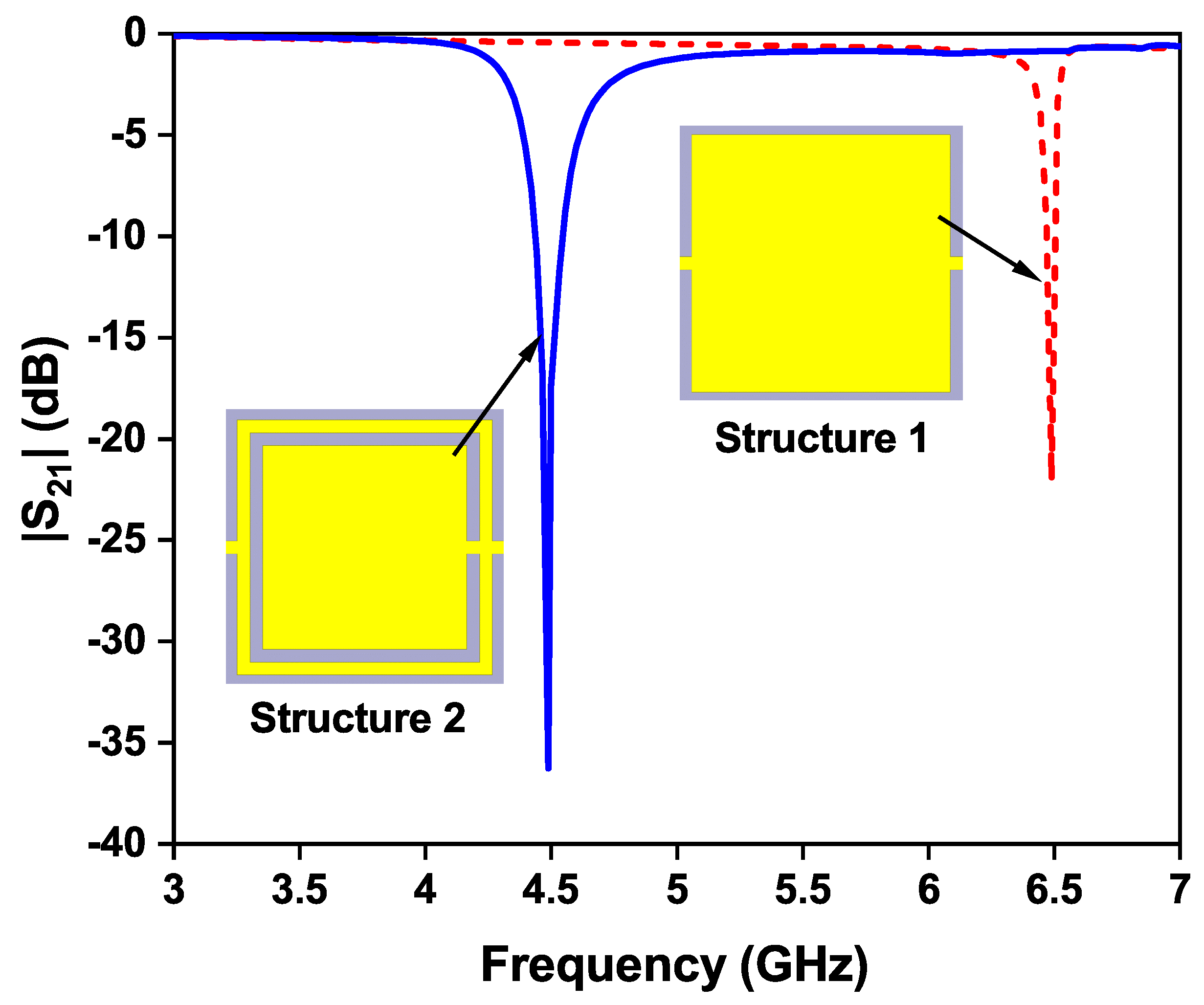
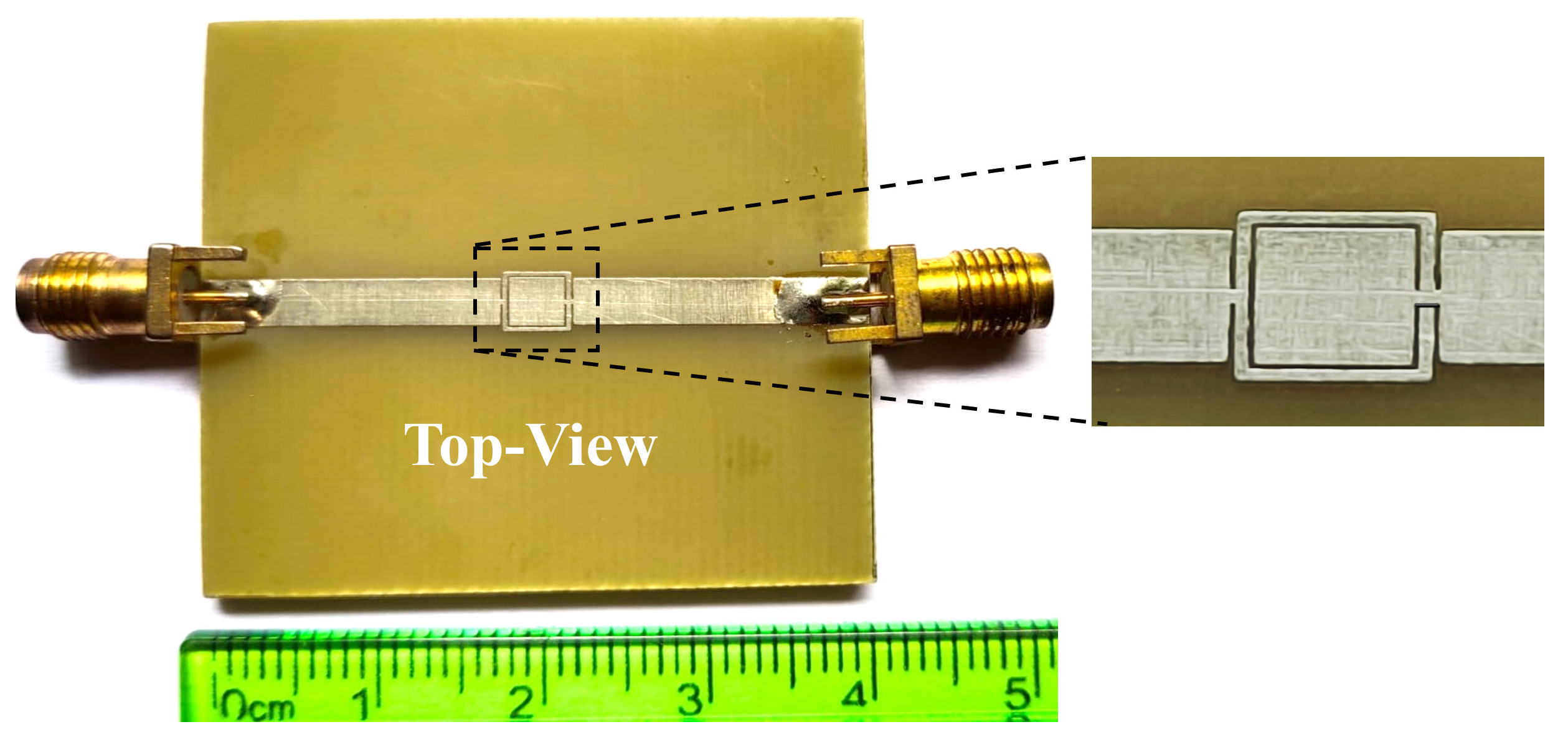



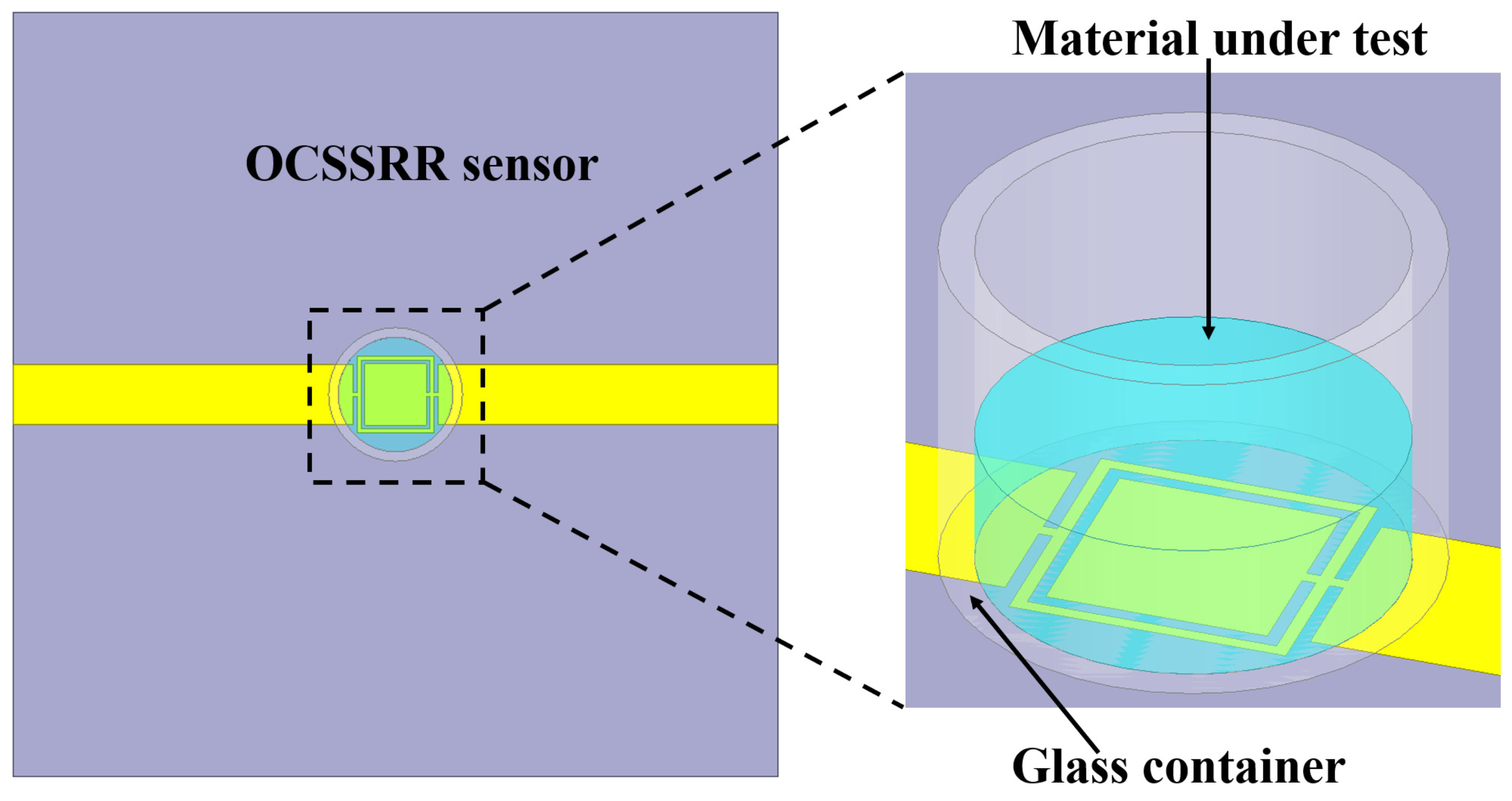



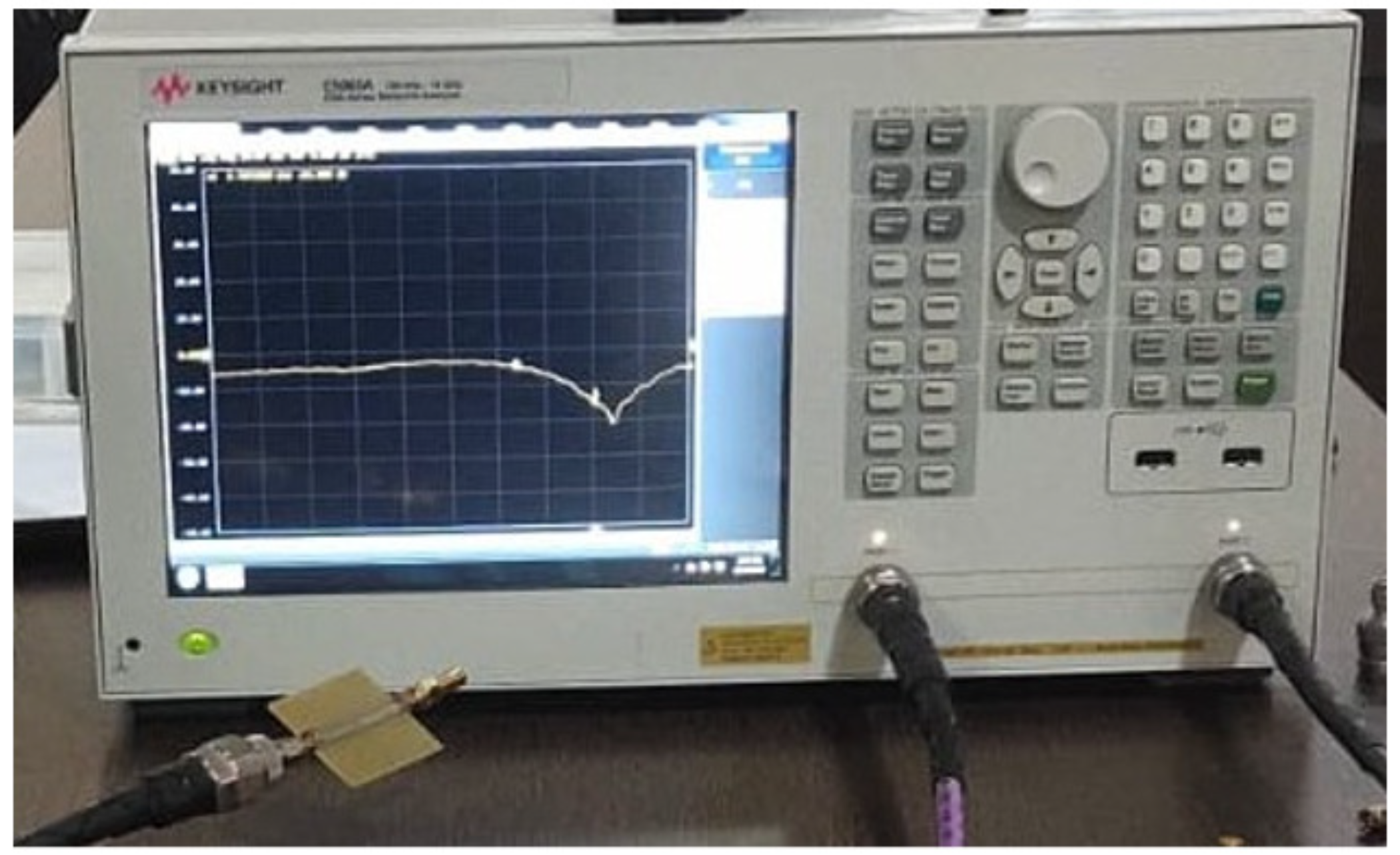
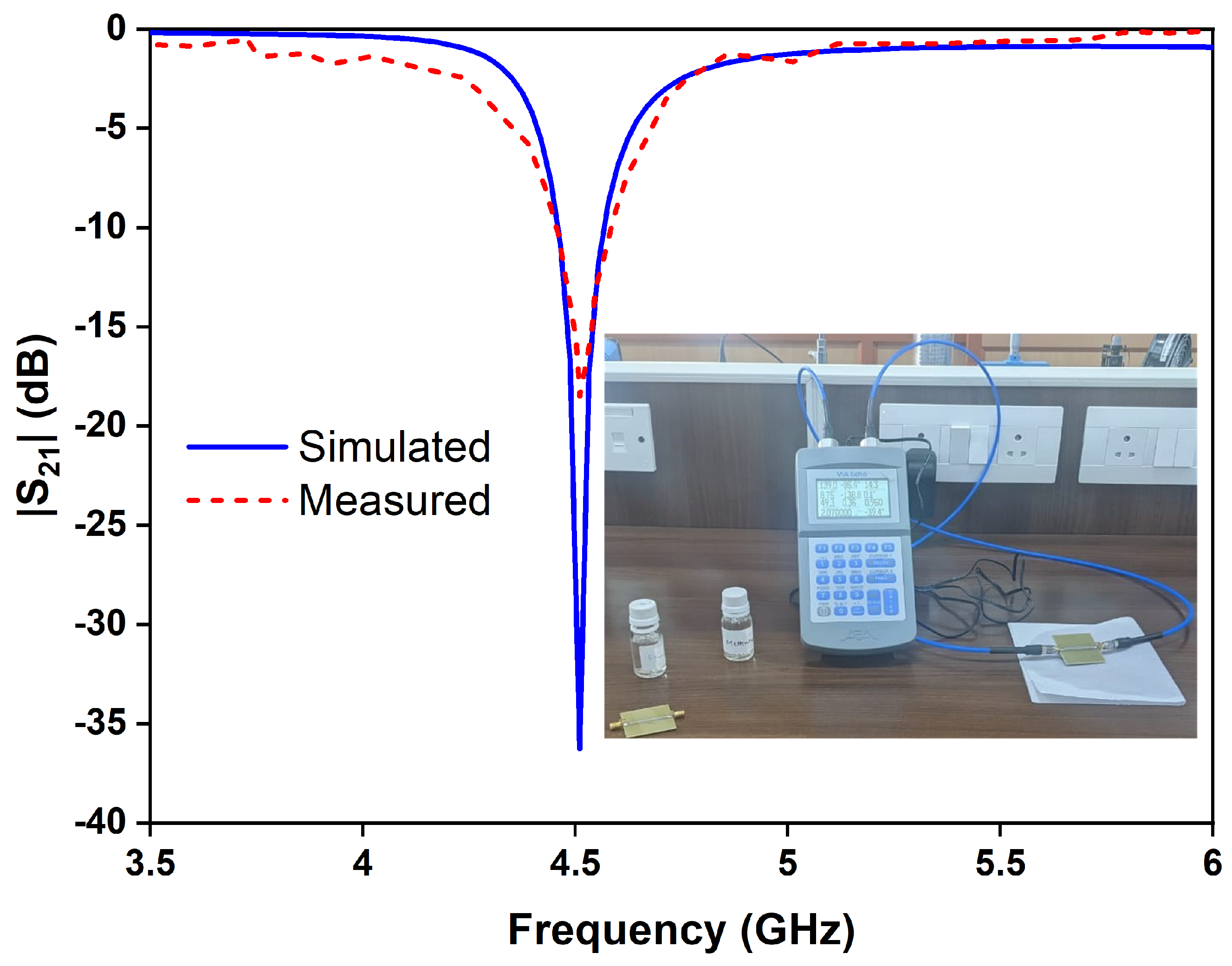

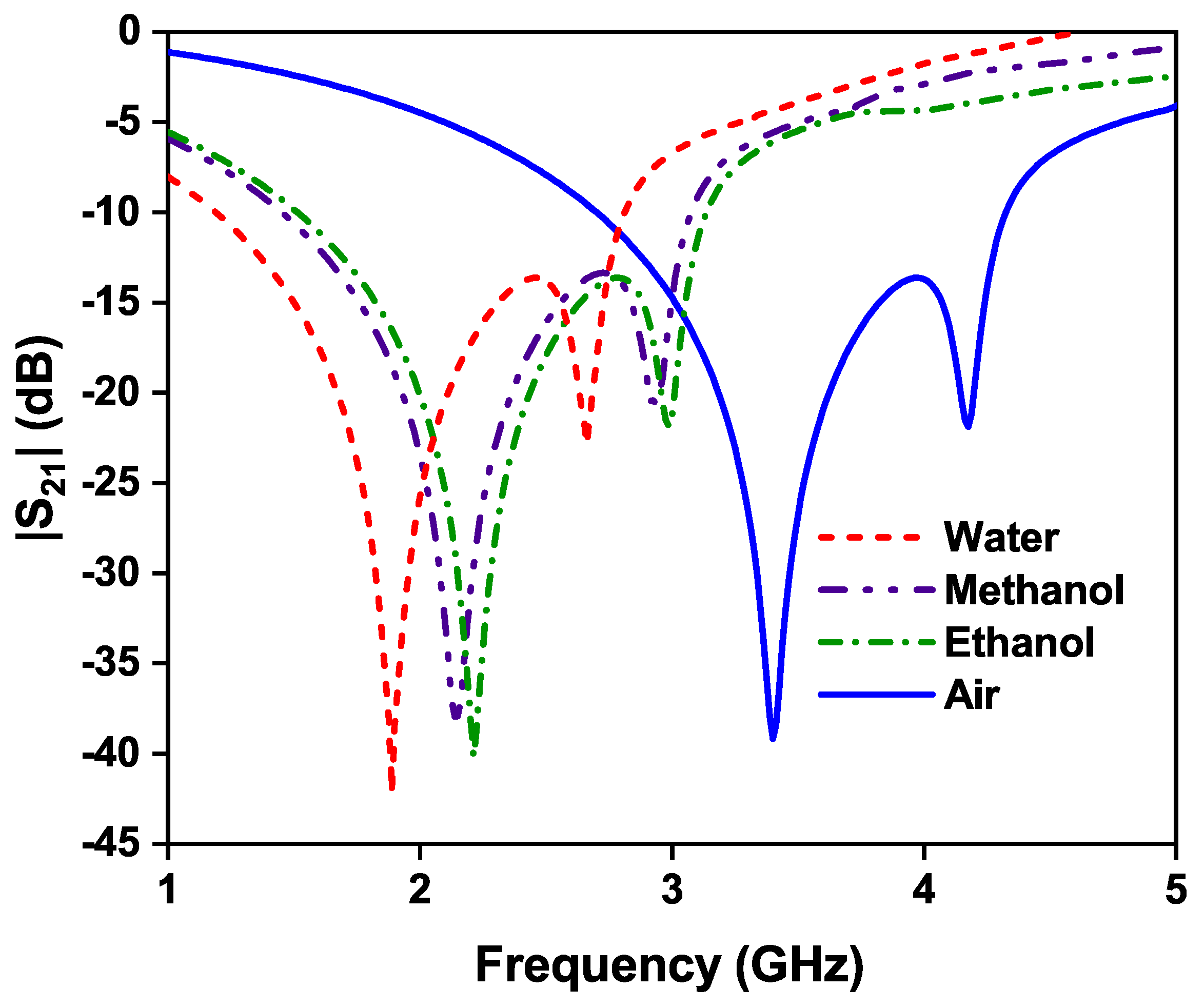

| OCSSRR | (Sensor 1) | ||||
|---|---|---|---|---|---|
| CDW (μL) | 20 | 40 | 60 | 80 | 100 |
| RF (GHz) | 4.19 | 3.92 | 3.72 | 3.52 | 3.36 |
| S21 (dB) | −31.36 | −25.03 | −21.73 | −17.82 | −13.81 |
| FS (MHz) | 310 | 580 | 780 | 980 | 1140 |
| Modified | OCSSRR | (Sensor 2) | |||
| CDW (μL) | 20 | 40 | 60 | 80 | 100 |
| RF (GHz) | 3.11 | 2.8 | 2.47 | 2.15 | 1.88 |
| S21 (dB) | −36.26 | −29.47 | −24.66 | −18.95 | −13.45 |
| FS (MHz) | 290 | 600 | 930 | 1250 | 1520 |
| OCSSRR | (Sensor 1) | ||||
|---|---|---|---|---|---|
| CDW (μL) | 20 | 40 | 60 | 80 | 100 |
| FS (MHz) | 310 | 580 | 780 | 980 | 1140 |
| RFS | 0.068 | 0.128 | 0.173 | 0.217 | 0.253 |
| Modified | OCSSRR | (Sensor 2) | |||
| CDW (μL) | 20 | 40 | 60 | 80 | 100 |
| FS (MHz) | 290 | 600 | 930 | 1250 | 1520 |
| RFS | 0.085 | 0.176 | 0.273 | 0.367 | 0.447 |
| OCSSRR | (Sensor 1) | ||||
|---|---|---|---|---|---|
| MUT | Frequency (GHz) | S21 (dB) | Frequency Shift (GHz) | Relative Permittivity | Sensitivity (MHz/RIU) |
| Air (No Load) | 4.5 | −36.26 | - | - | - |
| Ethanol | 3.72 | −33.73 | 780 | 24 | 200 |
| Methanol | 3.63 | −25.82 | 870 | 32 | 186 |
| Water | 3.36 | −19.41 | 1140 | 80 | 143 |
| Modified | OCSSRR | (Sensor 2) | |||
| MUT | Frequency (GHz) | S21 (dB) | Frequency Shift (GHz) | Relative Permittivity | Sensitivity (MHz/RIU) |
| Air (No Load) | 3.4 | −39.16 | - | - | - |
| Ethanol | 2.2 | −40.16 | 1200 | 24 | 308 |
| Methanol | 2.13 | −37.92 | 1270 | 32 | 272 |
| Water | 1.88 | −42.17 | 1520 | 80 | 191 |
| Ref. | Type of Resonator | Sample | RF (GHz) | FS (MHz) | Sensitivity (MHz/RIU) | LFM |
|---|---|---|---|---|---|---|
| [21] | CSRR | ethanol | 2.96 | 110 | 23 | glass tube |
| [20] | CSRR | ethanol | 2.5 | 180 | 46 | poly propylene tube |
| [31] | MLF | water/ ethanol/ methanol | 1.97 | 50 | 52 | glass capillary |
| [32] | CSRR | water/ ethanol/ methanol | 6 | 200 | 77 | PTFE tube |
| [30] | CSRR | water/ ethanol | 5.37 | 970 | 125 | microfluidic channel |
| [33] | MSRR | water/ ethanol/ methanol | 2.1 | 420 | 128 | capillary glass |
| [25] | SIW | ethanol/ methanol | 4.4 | 600 | 153 | glass capillary |
| [26] | SRR | ethanol/ methanol | 2.6 | 600 | 153 | plastic tube |
| [27] | GWCR | ethanol/ methanol | 5.4 | 610 | 156 | microfluidic channel |
| [22] | Series LC | ethanol | 1.91 | 610 | 156 | microfluidic channel |
| [28] | CCSR | water/ ethanol/ milk | 2.4 | 800 | 205 | precision pipette |
| [23] | CSRR | ethanol | 4.72 | 550 | 212 | microfluidic channel |
| [24] | CSRR | ethanol | 2.226 | 1046 | 268 | microfluidic channel |
| [29] | MCSRR | water/ ethanol | 2.45 | 1050 | 269 | capillary tube |
| TW | Modified OCSSRR | water/ ethanol/ methanol | 3.4 | 1200 | 308 | glass container |
Disclaimer/Publisher’s Note: The statements, opinions and data contained in all publications are solely those of the individual author(s) and contributor(s) and not of MDPI and/or the editor(s). MDPI and/or the editor(s) disclaim responsibility for any injury to people or property resulting from any ideas, methods, instructions or products referred to in the content. |
© 2024 by the authors. Licensee MDPI, Basel, Switzerland. This article is an open access article distributed under the terms and conditions of the Creative Commons Attribution (CC BY) license (https://creativecommons.org/licenses/by/4.0/).
Share and Cite
Ds, C.; Nagini, K.B.S.S.; Barik, R.K.; Koziel, S. Highly Sensitive Microwave Sensors Based on Open Complementary Square Split-Ring Resonator for Sensing Liquid Materials. Sensors 2024, 24, 1840. https://doi.org/10.3390/s24061840
Ds C, Nagini KBSS, Barik RK, Koziel S. Highly Sensitive Microwave Sensors Based on Open Complementary Square Split-Ring Resonator for Sensing Liquid Materials. Sensors. 2024; 24(6):1840. https://doi.org/10.3390/s24061840
Chicago/Turabian StyleDs, Chandu, K. B. S. Sri Nagini, Rusan Kumar Barik, and Slawomir Koziel. 2024. "Highly Sensitive Microwave Sensors Based on Open Complementary Square Split-Ring Resonator for Sensing Liquid Materials" Sensors 24, no. 6: 1840. https://doi.org/10.3390/s24061840





